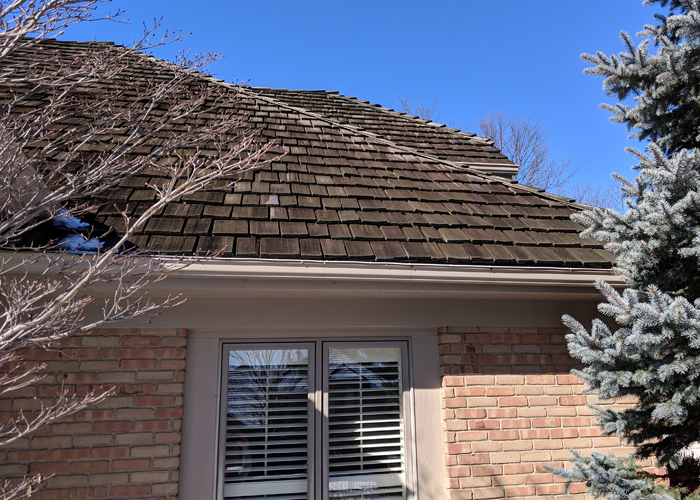
Product Comparison – Composite Cedar Shake Roofing
Part of an Architect’s job is evaluating products and materials for projects we’re working on. It’s surprising how much time I spend talking with suppliers about materials – even those I use frequently, that I’m completely familiar with, and that I’m comfortable recommending to my clients.
Sometimes those suppliers are refreshing my knowledge about an old favorite that I haven’t used in a while. But now and then, a particular job requires a new product, or a new product comes along that I’m interested in checking into.
If you’ve been following my blog for a while, you know that I prefer authentic materials whenever possible – real brick, real stone, real wood floors. And when it’s called for, real cedar shake/shingle roofing.
So I hadn’t paid much attention to the many “faux” composite cedar shake roofing products on the market until recently, when a local homeowner’s association asked me to evaluate several as possible alternatives to cedar shake and cedar shingle roofing in their neighborhood.
I’d heard of one or two of these products, but quickly found out that there are more than a few composite cedar shake roofing products out there made from several different materials. I ended up looking into nine of them (note – I’m reviewing just eight below, one appears to be out of business).
Before I get into my reviews, let me point out a few things.
First, cedar shakes and cedar shingles are not the same thing. Shakes are hand-split (or look like hand-split) and shingles are sawn (or look like they’re sawn). Got it?
Second, none of the products I reviewed are less-expensive to install than real cedar; some are significantly more expensive. The advantage most have over cedar is a lower cost of maintenance and a longer lifespan – although I’ll add, as something of a purist, that cedar will last a very long time if you care for it properly. (Disclaimer – I own a home with a cedar shake roof – the photo at the top of this article is a cedar shake roof).
Third, some of these products are significantly heavier than cedar roofing, which means you might have to account for the additional load in a new home design or beef up the structure on an existing house.
Finally, most of these products are similarly durable, so my reviews are more about their aesthetic properties than anything else.
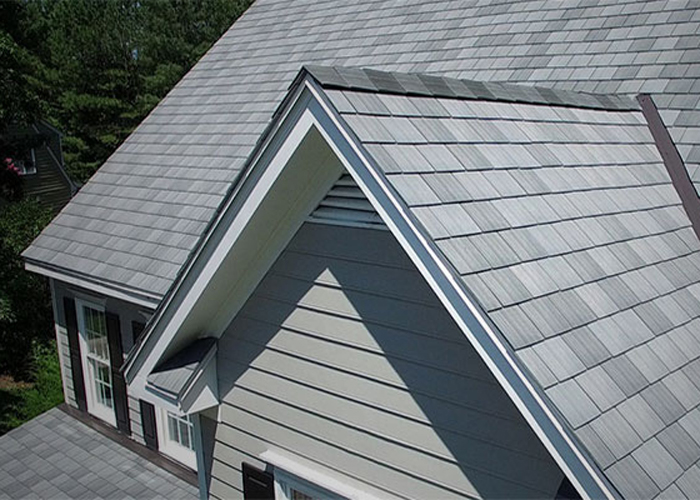
PlyGem Engineered Cedar Shake
https://www.plygem.com/wps/portal/home/brands/plygem-roofing/engineered-cedar)
The Facts
Although PlyGem calls their product a “shake” it’s really more of a shingle, since it doesn’t have the thickness and random character of real wood. PlyGem’s product is a composite and includes recycled plastic. It’s offered in a variety of widths, which helps give it a more authentic look, and is available in three shades of grey and brown. PlyGem warrants the Engineered Cedar Shake for 50 years, with a 10 year no-fade warranty.
My Take
This is a reasonably attractive, durable roof with a decent warranty. It looks pretty good on a house, but it’s not what I’d call a replica of a cedar roof. If anything, it vaguely mimics cedar shingles, but not cedar shakes. From a distance, the grey color looks a bit more like slate than cedar. The 10-year fade warranty has me wondering what color this product ages to. I would consider this more of a higher-end production-house product than a custom home product.
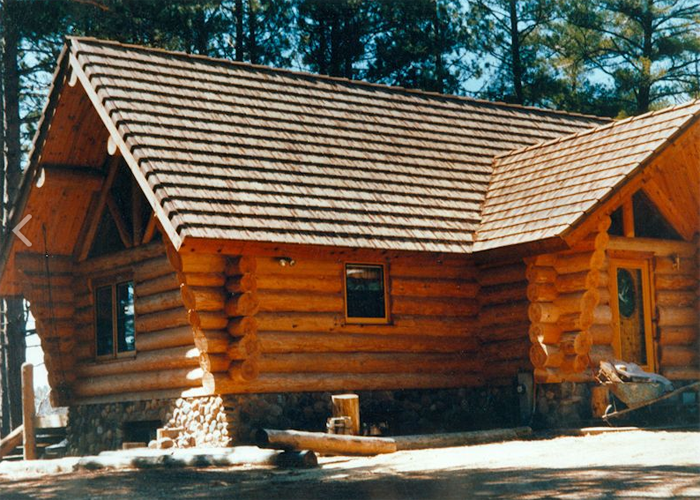
Vande Hey Shake Tile
(https://www.vrmtile.com/shake.php)
The Facts
Vande Hey’s “Shake Tile” is made from concrete, a very durable material commonly used in hot and coastal climates (although it can be used almost anywhere). Vande Hey offers a wide choice of standard colors and can also create custom colors and color blends. It requires a fairly complex installation process (as is the case with all tile roofing products) but has a limited lifetime warranty when installed properly.
My Take
The natural variations in thickness and shape of all tile products helps to create a more authentic look, but no one’s going to mistake this for a real cedar shake roof. That doesn’t mean the product isn’t attractive, however – it makes a very good-looking roof. Part of the reason it doesn’t meet the “fake shake” test is the nature of the gable-end pieces – they wrap the roof edge, unlike cedar shakes. I could easily see using this product on high-end custom home projects.
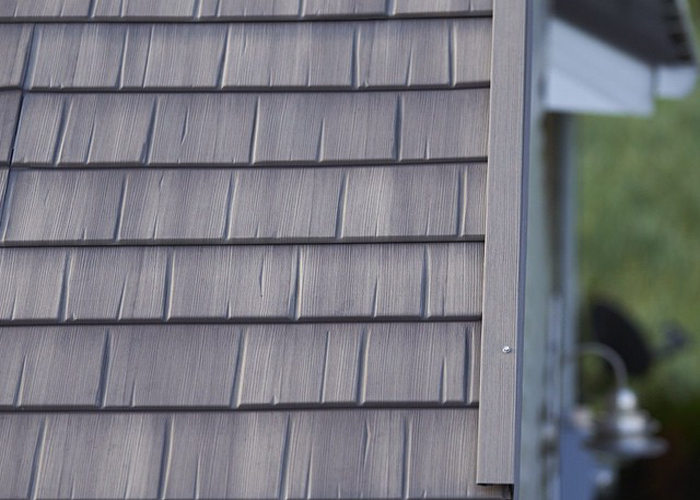
Certainteed Matterhorn Shake
(https://www.certainteed.com/residential-roofing/products/matterhorn-metal-roofing-tile/)
The Facts
Matterhorn Shake is a steel product with a painted surface, the only metal product in this review. It’s installed in panels that are 48” long and 20” deep and is offered in four colors. Certainteed has a limited lifetime warranty on Matterhorn Shake.
My Take
This product is misnamed – it’s nothing like a “shake”. The 48” panels don’t have the deep clefts and wood grain texture that distinguishes cedar shake roofing, and the edges of the metal panels make them look like, well, metal panels. The other big drawback is how the product is installed at rakes and how it’s flashed to walls – both conditions require a proprietary counterflashing that cheapens the overall appearance. On the plus side, the colors appear to mimic weathered cedar roofing well.
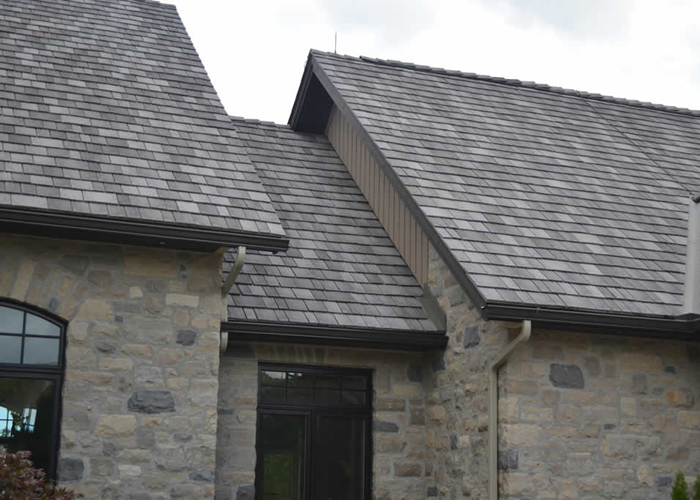
Enviroshake
(https://www.enviroshake.com/)
The Facts
Enviroshake is a composite product containing recycled plastics, wood fibers, and elastomers (rubber). It’s manufactured in individual pieces that are about the same size of cedar shingles, which gives it a more authentic look. Enviroshake comes with a 50 year limited warranty and comes in two colors, and a blend of the two colors.
My Take
This company makes two “cedar” products – Enviroshake and Enviroshingle. I’m not reviewing the “shingle” product at all here, as it’s nothing like cedar. Enviroshake, however, looks pretty good (although it looks much more like a cedar shingle than a cedar shake). I like that they have ridge and hip caps that look correct, and that the gable ends and wall connections don’t require special pieces. Rumors are out there that this product smells like rubber tires for a few weeks after installation – not surprising, considering it contains recycled rubber.
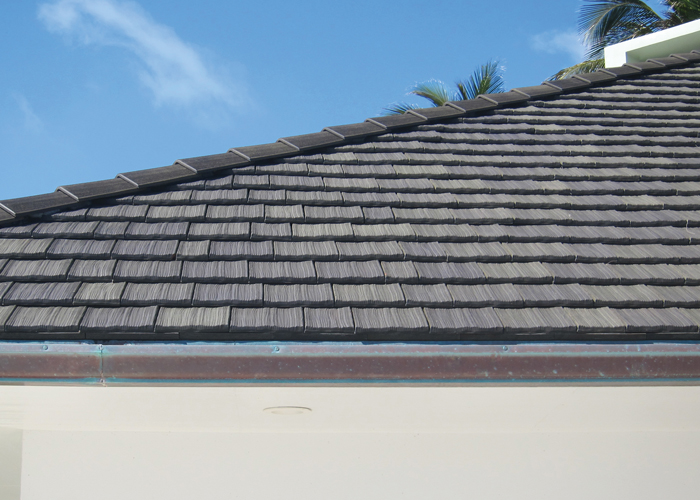
Ludowici Shake Tile
(https://www.ludowici.com/products/roof-tile/shake-tile/)
The Facts
Ludowici offers two faux shake products, “Century Shake”, a thick-profile heavy-weight tile for new construction, and “Ludoshake”, a lighter-weight product intended for remodeling. Both are made from Terra Cotta, one of oldest and most durable building products in the world. Century Shake is available in 5 colors and blend, Ludoshake in 6 colors and blends. Both have a 75-year material warranty.
My Take
These products are the top of the line in the “fake shake” comparison. The Century Shake product is as close a replica to real cedar shake roof as you’ll find today. As with all tile products, installation is more complex. While special gable-end pieces are required for this product, they are smaller and less visually obtrusive than some other manufacturer’s materials. This is as close to a “forever” roof product as you can get, and I wouldn’t hesitate to use it for a high-end custom home project.
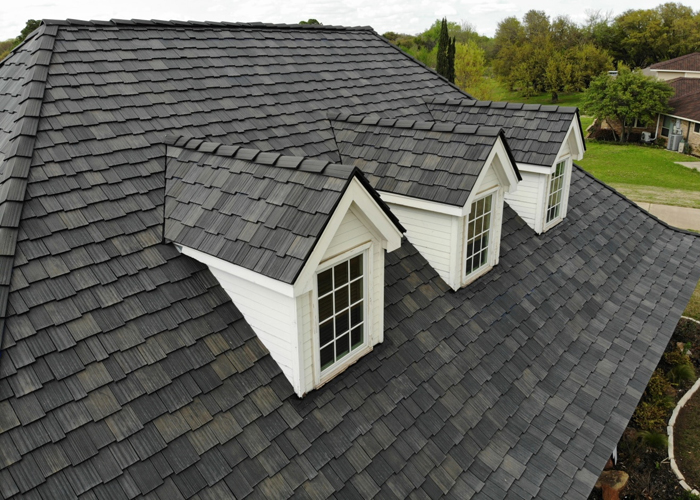
DaVinci Roofscapes DaVinci Shake
(https://www.davinciroofscapes.com/products/shake/)
The Facts
DaVinci Shake is another plastic roof product, although it doesn’t contain any recycled material. It’s crushed limestone, mixed with a plastic binder. DaVinci offers three faux-cedar products – “Bellaforte”, a thick shake that is molded from actual cedar shakes; a “multi-width” shake, and a “single-width” shake. The single and multi-width products are more like shingles than shake and are not as thick as the Bellaforte. All are available in nine colors.
My Take
As plastic roofing products go, this is probably the most realistic available. Installation is very similar to asphalt shingles and doesn’t require special flashing details. End caps are required for the Bellaforte product, but they are smaller and more realistic-appearing than some other plastic roofing. From a distance, it’s possible to mistake this for a real cedar shake roof.
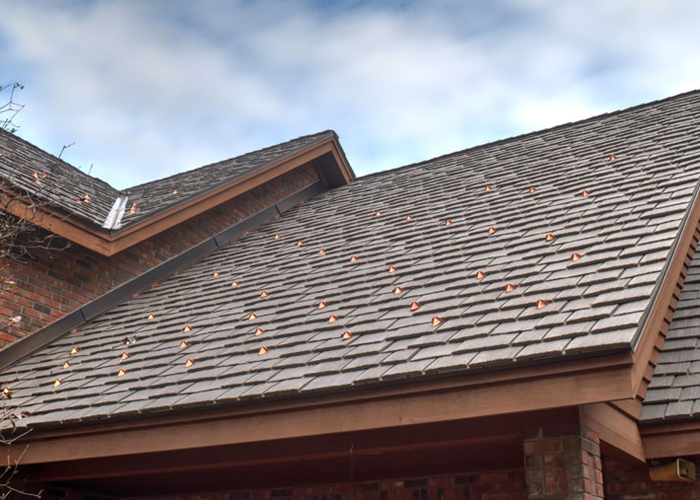
EcoStar Empire Shake
(http://ecostarllc.com/product/empire-shake/)
The Facts
EcoStar sells two “shake” products – “Empire Shake Plus” is extra thick, similar to real cedar shakes. “Empire Shake” is a thinner product, more like a cedar shingle. The texture of both is similar to real cedar, and both are offered in 14 colors. Custom colors and blends are also available. Both are plastic and include some recycled content. Installation is similar to asphalt shingles, and special flashing details and end caps are not required. Both products carry a 50-year material warranty.
My Take
A reasonably attractive product, although the pattern and texture is not as convincing as DaVinci. My biggest concern is the color choices – none appear to mimic aged cedar very well, and some are a bit odd, like bright orange and bright red.
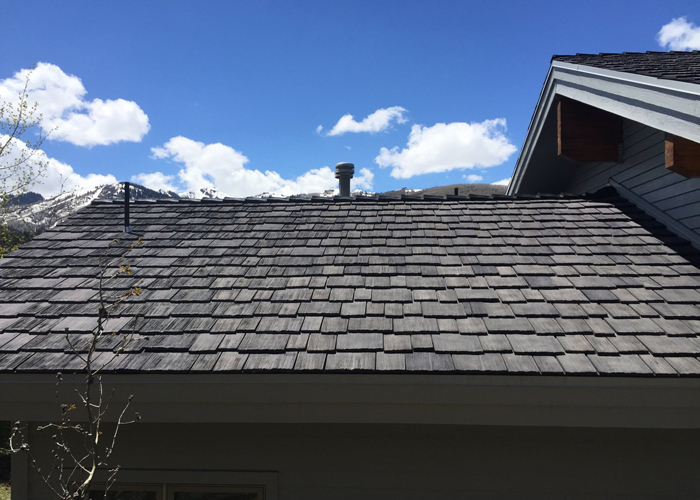
CeDUR Simulated Wood Shakes
The Facts
CeDUR’s product is a plastic, thick-butt shake alternative made from closed-cell polyurethane. Unlike other plastic shakes, CeDUR is a solid product; others have a cavity-back to save material and weight. CeDUR’s pattern, texture, and thickness is a good representation of real cedar shakes. CeDUR comes with a 50-year warranty, and is available in four colors. Installation is similar to asphalt shingles, and no special flashing or gable end pieces are required.
My Take
This is the only solid plastic fake shake I reviewed. At first glance, this seems like a significant visual advantage over cavity-back shake products, but I’m concerned that solid shingles are more likely to warp in high heat conditions. In fact, CeDUR’s warranty excludes warping from heat reflected from glass and other sources – something not under a homeowner’s control. I’m also concerned with the available colors, none of which mimic weathered cedar very well. In spite of those two concerns, however, this appears to be a very attractive product with a realistic rustic cedar shake appearance.
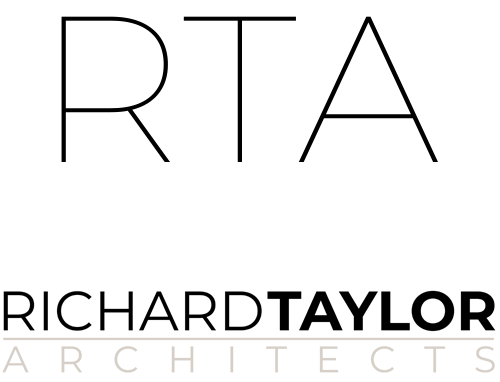


What do you consider proper care for cedar shingles? I am wondering specifically when you want them to be black?
Hey Millie – the answer is…it depends. Climate has a huge impact on how much maintenance cedar roofs need. In dry climates, they need very little. In humid climates they might need looked at every few years. Bottom line – keep a cedar roof free of leaves and other organic debris, repair damaged or missing shingles, and most important – don’t let moss or lichen grow on cedar roofing for any length of time. As far as them being “black”, that depends, too. Some cedar shingles look black when they’re wet, but if your cedar roof is dry and still looks black, you should probably have a roofing pro check it out.
The ladder/spaced decking beneath many authentic shake roofs poses a bit of a problem with a replacement product. I’ve reviewed other composite “shake roofs” (not in your list….and a few that are out of business now) about making the span between decking boards and have not found a suitable replacement. The installation guides point to a solid decking to attach each shake…and none suggest simply nailing down to existing shake roof.
Given the price per square…for the moment, it appears that #1 Taper splits are starting to return back to reason (materials is little more than 3 times labor)…which was the only option that I was coming up with. There was a peak value per square for cedar shakes that was nearly as expensive as a weathered green or gray slate….for materials and labor with install labor about 2/3rd the price of materials. Of course the roof here wasn’t designed for the load…but again, I was poking about for my options which slate load was prohibitive because the owner is a tightwad and didn’t want to bulk up the roof.
anything cross your path on remods or rennovs for composites using opening decking? Cedar is quite the commodity here in Georgia…which may be the reason for the few Cedar techs or whole roof sales. Thanks for the great article!!
Dan – I’ve done slate over spaced sheathing, but not cedar. Too risky, there are too many potential places where leaks could develop. Depending on the size of the gaps, you might be able to get away with double felt or Ice and Water Guard…but if you’re down to the sheathing, I’d probably toss a layer of plywood on top and sleep better!
I get the impression that the spaced sheathing is for the convenience of the roofer. It’s been a watertight 30 years, but the lack of alternatives for an R&R is getting to be a major inconvenience. We’re lacking in cedar roofing specialists…there are only a very small handful to service the metro Atlanta area.
This article was very useful to me. We are hiring someone to put a roof on our home, and neither my wife nor I have ever done this before. We live in a fire hazard zone near Los Angeles, so real cedar is not a possibility. Thank you so much for posing this information.
what did you go with? we live in la and are about to replace our roof with a synthetic shake?
We had a house near the block which used the DaVinci Shake material and it still looks brand new after almost 5 yrs (installed in 2015). We need to do our own original roof soon (Cedar Shake) and after months of research may just go the route of synthetic/polymer shakes. You can’t find too many good installers for cedar anymore, and the lumbar used is no longer old-growth (tough to find). The problem is… We can’t really find any online reviews for these type of faux roofs. Any issues that crop up? Which vendor is the best? I’m assuming these types of roofing materials are just still really new. I hardly ever see them being discussed unlike composite, cedar, metal, tile, slate, and concrete.
Philip – my only direct experience is with DaVinci, it’s a good product. Regarding real cedar, “old growth” doesn’t really matter – high-quality cedar shakes and shingles are still available. What’s important is getting certified products (see this link http://www.cedarbureau.org/) and maintaining the shingles. A good cedar roof should last 35 years or so in most parts of the country (and nothing looks quite like real cedar!).
If I’m looking for:
1. the longest lasting “plastic like/vinyl like” roof shingle.
2. “Architectural shingle like” installation; so a “good” roofer can handle it.
3. Low-ish cost.
And I’m not that critical about looking like real Cedar but want a nice look. My home is brick front & sides and vinyl siding back.
You reviewed several plastic type shakes/shingles; can you say which would best fit the above ?
Thanks
Bill – I would probably go with the PlyGem product in your situation. I don’t have cost information, but I’m guessing it’s one of the lower-priced products on my list.
Hi Rich!
I hope you are doing well. Gregg and I are looking at new roof options, and as you know we have real cedar shake now. We have had a real struggle finding a roofer that will even do cedar shake, and then we learned that the hrc allows composite shake or composite slate in our historic neighborhood. We started doing some research, and low and behold you (our favorite architect) address this topic in your blog! How fortuitous.
We also learned that our original house plans called for slate, but the owners went with shake. You know our home well. Do you have a preference for composite shake versus the composite slate on our 1930s colonial? Also any advice on the best brand? We found a few other brands out there that look to be pretty realistic, but probably very high end. Any experience/ knowledge of Brava or certainteed?
Thanks so much,
Nicole and Gregg
Hello Nicole and Gregg – I don’t have any direct experience with the Brava product, unfortunately. From what I can see on their website, however, it appears to be a very attractive roofing material. Up close, it looks very, very similar to the DaVinci shakes, including the way the cavity back is composed – it would be interesting to see both side by side! The key to getting a great look is the installation. I’ve been involved with a couple of faux shake installations recently and the installation makes all the difference!
I actually have samples of each side by side. The Brava sample is more pliable, and overall seems a bit more realistic and attractive. The DaVinci sample is more ridged. They are actually quite different up close, though I am not sure you can say one is objectively superior over the other just by looking at them.
Brava tiles are heavier in weight, and overall seem, to me at least, a little bit better engineered. The DaVinci sample very much feels and looks like hard plastic while the Brava tiles have more ‘give’ with a more matte appearance. Neither, though, are what you’d classify “flexible” or “flimsy”. Both are a solid piece of plastic and neither would get lifted up by wind or anything like that. Hail would just bounce off either without any issue.
The brava example seems a bit more acoustically dampened. I think both would hold up well under stress, but being less ridged I think the Brava tile could potentially have better impact performance, though I don’t think either is necessarily inferior just by looking at them.
I have samples of Brava and DaVinci and found the Brava to be better a product. I scratched my fingernail about 5 times in the same place on a DaVinci tile and took it down to white plastic.
Thank you for this very informative article. Could you provide the color of the DaVinci Bellaforte synthetic shake in this article? It looks outstanding, but doesn’t seem to exactly match any of their colors. Is it a mix of Mountain and Weathered Gray? There is variation in the shake colors, which makes it looks like a mix.
Thank you!
I have received samples from Enviroshake and Brava. Brava is considerably more realistic but also expensive. In your opinion, how do they compare to Davinci? I am specifying for a client project and a new build of my own.
I too am interested in replacing a cedar shake roof with synthetic shakes and have looked at both Brava and DaVinci. I am interested in your opinion of these two products. I live in Hawaii and have to deal with a lot of rain and hurricanes.
We have an old 1895 2-story farmhouse in Los Angeles area with a wood shingle roof that has maybe 3 yrs life left. Love wood but don’t like the fire hazard. Shake might be better than shingle, in my opinion. Weight is an issue for our house. Also, some tile is very brittle…can’t walk on it (e.g., cedarlite). So what cedar tiles do you think we should consider?
Have you reviewed Brave materials? If so what are your thoughts?
Hello
Thanks you for the review.
Do you have a more updated review on the CeDur product.
Thinking of using it on Cape Cod
CeDUR vs. DaVinci?
Hello John Quill,
I read your question about CeDur shake shingles on this site: https://www.rtastudio.com/2019/02/composite-cedar-shake-roofing-residential-architect-ohio/ I was wondering which you went with….the CeDur or the Davinci? I am now needing to replace my shake roof in Colorado and love the look of CeDur over DaVinci but am worried about the the weight. I was wondering what shake you went with and how do you like it? Do the crevice’s (such as in a dormer) need a metal flashing? I want something as natural looking as possible. Thank you, Diane
Richard,
What are your thoughts on Brava Roof Tiles?
Having looked at various synthetic shakes online and receiving samples of of Cedar Lite 600, I like the CeDUR product the most as far as similarity to actual cedar shake. I have a 100 year old home in Los Angeles. Called the CeDUR company and was told their shake does not warp and can be walked on without fear of breakage to service it. I like the fact that also, it is much lighter than the Cedar Lite product. Can you see any negatives to the CeDUR product besides price which I think is somewhat more than other synthetic shakes?
Any new ideas on Davici vs cedur? Have you seen warping of cedur? I am looking for a composit type shake shingle.
Hi Lance, Yes , these newer companies like Cedur are having issues. Cedur, Foam shingles, will likely not survive as the same company with the curling issues. Ecostar llc is the oldest formulation that seams to be holding up. what do you think of them ?
Hi Lance, I’m curious what you went with…CeDur or DaVinci faux shakes? I love the CeDur look but worry about warping and any weight issues. my neighbors have the DaVinci but, to me, those don’t look at authentic as CeDur. thx, Diane
I am also deciding between CeDur and Brava and would love more input. I really don’t like the look of the Davinci. They look like a lego roof to me, so plastic-y. Thoughts? Thanks!!!
Did you go with CeDur and are you happy with your choice
Get free samples, always! CeDur samples arrived today by FedEx, after taking one out of the box, I was disappointed in how thin it is. The sample broke into 2 pieces in my little hands, and I’m not strong, I wasn’t trying to break it but slightly bent it, and hurt my hand. How’s it gonna hold up if a person walks on it or the extreme climate bends it (4′ snow?) Feel the samples, look at them outside in the sun and in the shade.
Can you tell me how Davinci roof tiles perform after numerous years? Have you had any leaks or cracking/warping/curling on any of the Davinci roofs you have installed?